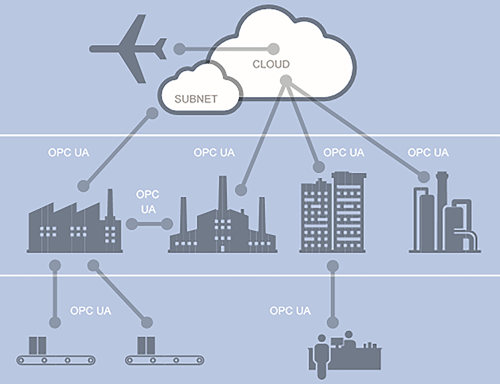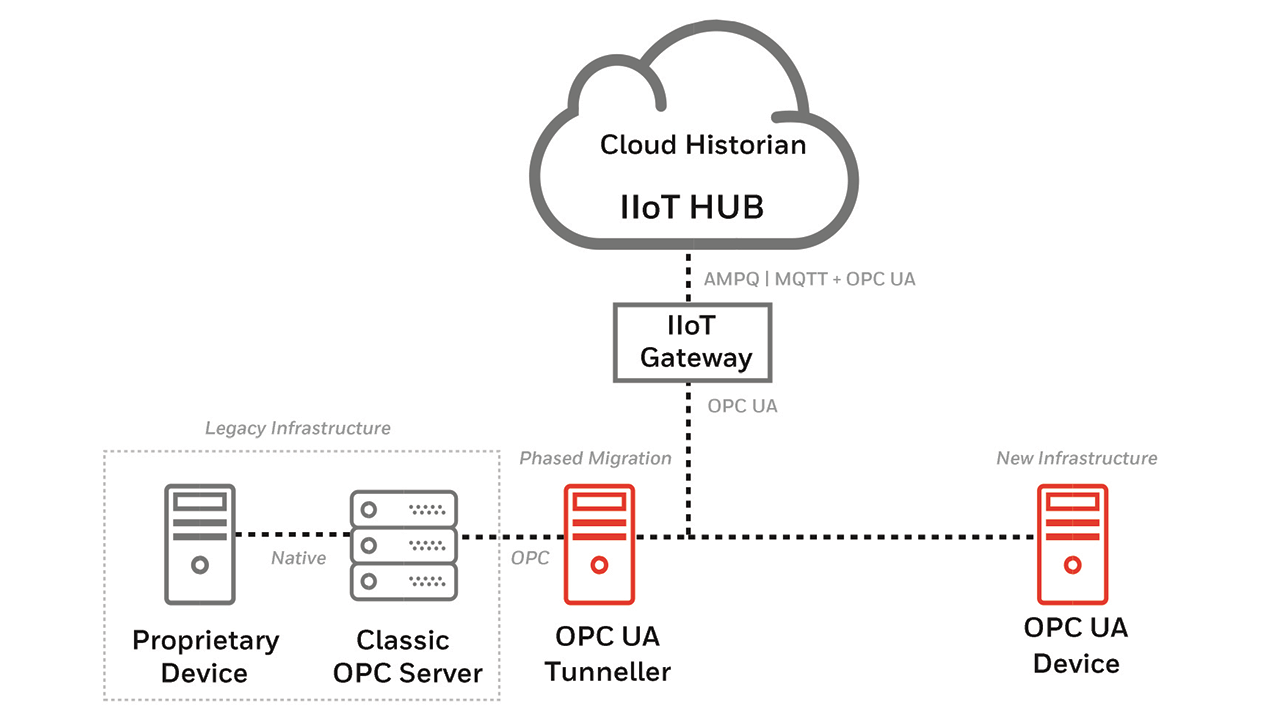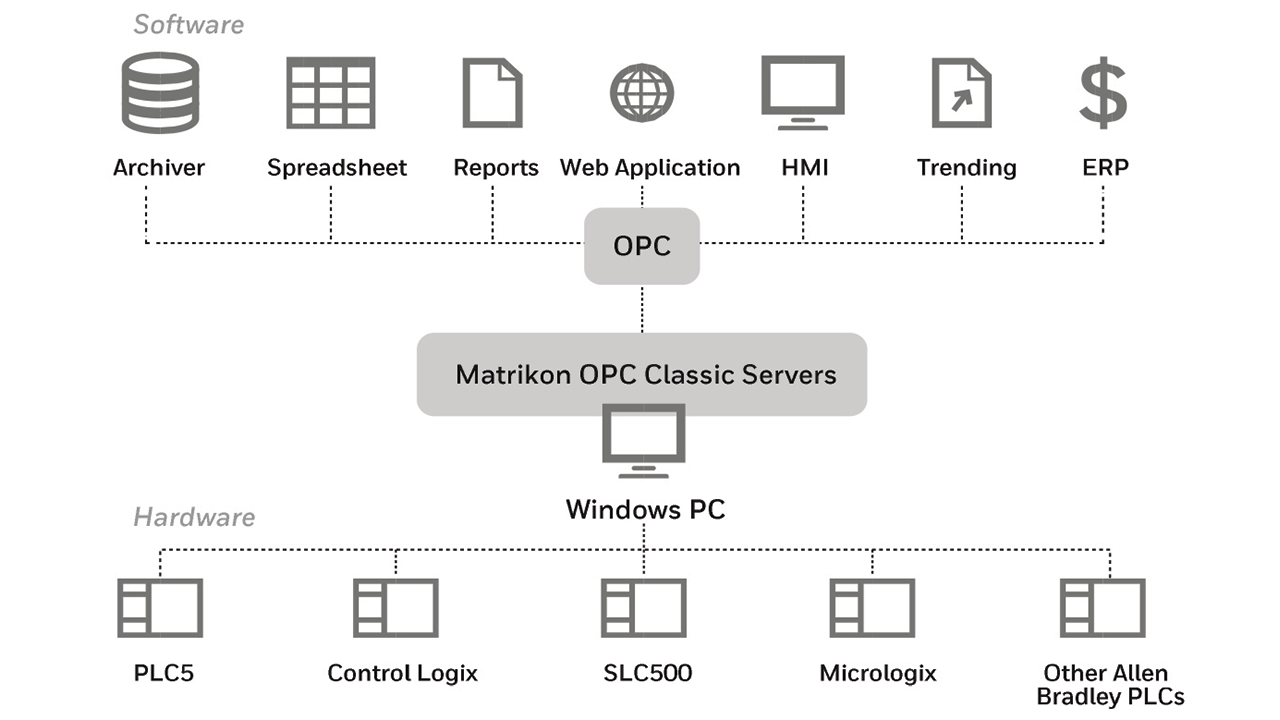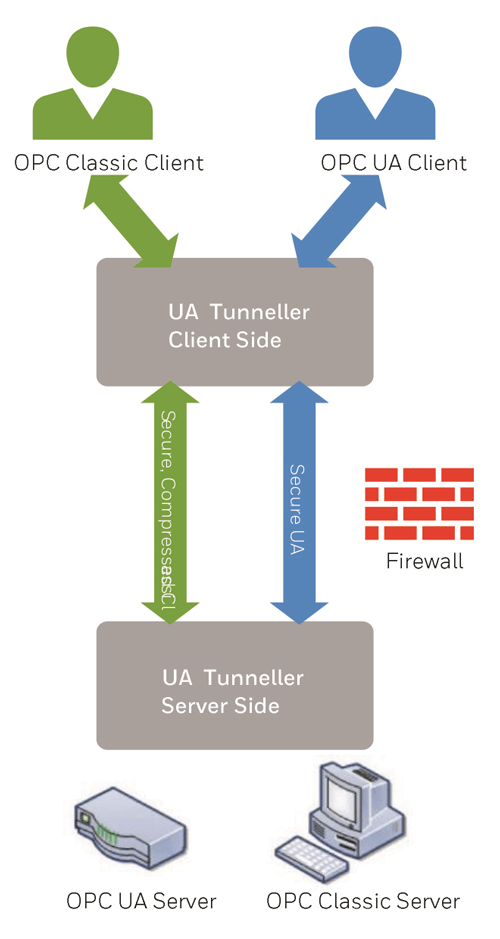TechnologyMay 10, 2018
Best practices: migrating from OPC Classic to OPC UA

An effective strategy for for migrating from OPC Classic to OPC UA employs important steps to minimize the time, cost and risk. With best-in-class OPC products and application expertise, it can be easy to assess the needs of your organization’s migration requirements and then assist with a seamless, end-to-end solution.
Now more than ever, industrial firms need to make sense of vast quantities of data having a critical impact on their performance. To support the variety of applications necessary today, information must be delivered with context so it can be understood and used in various ways by a variety of people.
Growing adoption of the Industrial Internet of Things (lloT) and lndustrie 4.0 is also driving requirements for open and secure connectivity between devices and edge-to- cloud solutions.
Organizations that deploy the OPC Unified Architecture (UA) will be able to better leverage plant floor-to-enterprise communications as a vehicle to participate in lloT applications. OPC UA is a standard for moving information vertically through the enterprise of multi-vendor systems, as well as providing interoperability between devices on different industrial networks from different vendors.
This article provides an overview of the key features of OPC UA, a comparison with the legacy OPC Classic standard, and strategies for upgrading to OPC UA based on a managed, secure and seamless migration path.
Introduction to OPC UA

The OPC UA standard offers key advantages in integrating industrial systems from the sensor to the cloud.
The OPC standard, first issued by the OPC Foundation in 1996, allows for secure and reliable exchange of data across manufacturing and other enterprises. OPC Classic is the world’s leading technology for integrating different automation products. Countless OPC–based systems are in use around the globe, ensuring the safe and reliable exchange of data between industrial software components.
The most widespread specifications of the classical OPC standard include: OPC DA for the transmission of real-time data, OPC HDA for the communication of run data (or historical data), and OPC A&E, with which alarms and events can be communicated.
These OPC variations are based on communication protocols from Microsoft: Component Object Model (COM) and Distributed Component Object Model (DCOM). All control systems, machine interfaces, and automation applications that are based on the Windows platform can exchange data smoothly with OPC Classic. Programmers are able to quickly realize interface implementations thanks to these close connections with Microsoft’s object-oriented COM and DCOM technologies, but this comes at the expense of the flexibility and expandability of interfaces.
In order to guarantee interoperability using OPC Classic, a separate OPC Server is needed for each device in a plant application. The use of multiple OPC Servers to connect all devices and applications may, however, lead to the internal communication structures becoming unclear and difficult to manage.
With OPC UA, the next generation OPC technology, the vision of “global” interoperability will become a reality. OPC UA supports cloud integration to scale operations when necessary, protects against IT hardware obsolescence, and delivers global access to connected systems. When integrated with the IIoT, it helps automation users to visualize, analyze and mobilize critical data without the need for added IT infrastructure.

The easiest and by far the most common topology is the cascading sus, but a star topology offers benefits.
The OPC UA standard was developed to break down communication barriers that have been limited by dependence on Microsoft’s underlying DCOM technology. Furthermore, the design of the new architecture works with any operating system (OS) without compromising the performance of the data exchange mechanism, making it the perfect solution for embedding OPC technology into devices.
OPC UA is a platform-independent, scalable, service-oriented architecture (SOA) that integrates all the functionality of the original OPC specifications into a single, flexible framework. It extends the capabilities of the original OPC model by improving upon security and employing standard web technologies.
OPC UA represents a major step forward for original equipment manufacturer (OEM) device manufacturers developing the latest breed of automation solutions. Developers can exchange rich data with even greater levels of interoperability, while enhancing security and providing new levels of value and performance.
Those who deploy OPC UA will be able to better leverage plant floor-to-enterprise communications as a vehicle to participate in IIoT and Industrie 4.0 applications. This technology supports multi-vendor, multi-platform interoperability for moving data and information from the embedded world to the enterprise. The standard is built on an information model that provides structure and context to information at its source, which is critical to have responsive systems. By adopting OPC UA, automation vendors get the best in open data connectivity today and in the future.

A new breed of software tools provides a secure method for migrating OPC Classic data to OPC UA.
Drivers for technology upgrade

OPC UA Tunneller simplifies migration planning by seamlessly integrating OPC UA Clients and Servers with the OPC Classic architecture.
Growing worldwide recognition of OPC UA’s benefits is pushing it into mainstream adoption. The technology is the industry’s most multi-faceted and promising specification for data exchange. OPC UA offers and expands the standard functionality of OPC Classic and, in doing so, resolves the difficulties associated with security, platform dependence, and DCOM problems.
There are several important drivers for migration from OPC Classic to OPC UA:
By natively enabling OPC UA in devices and applications, users no longer have to rely on clumsy tools for protocol translation and information modeling. This solution reduces both operating expenses (OPEX) and capital expenses (CAPEX) by eliminating middleware on the shop floor as well as the need for hardware to install servers and clients.
The number of attempted cyber-attacks on industrial facilities and critical infrastructure is on the rise. Unlike OPC Classic, OPC UA is inherently secure, and thus does away with the need to layer multiple security gateways or software. OPC UA offers a rich set of functionality, including the ability to provide contextualized data that is valuable for advanced analytics to enable improved insights and better decision-making.
With the ongoing shift to OPC UA, engineers, IT, and system Integrators alike need to properly integrate new UA-based data sources (i.e., devices and applications) into their existing OPC Classic-based architectures.
It is clear that switching to OPC UA is worthwhile, and for those developing tomorrow’s intelligent devices, it’s a necessity. OPC Classic simply cannot address the requirements of Industrie 4.0 or the latest IIoT initiatives.
Strategy for seamless migration
A growing number of OPC Classic users are starting to ask themselves how and when they should begin the implementation OPC UA. In many cases, however, the migration path to the new standard is not clear. There is often a lack of understanding of how OPC UA works, and even after the decision to transition has been made, there may be confusion about the best approach.
Many users are also reluctant to “rip and replace” existing investments. Automation assets are typically supplied by different OEMs who maintain proprietary protocols, and are concerned with protecting their installed base. All too frequently, the customer has no choice but to purchase new products in order to access new OPC UA features.
The aforementioned obstacles make technology migration both costly and difficult to manage. It is safe to assume that OPC UA will one day replace OPC Classic. An immediate switch to OPC UA, however, is not necessarily required for every business. With the right tools and careful planning, the migration process becomes clear.
Honeywell regards the OPC UA standard as a key enabler of its Connected Plant solution, which is meeting the need for enhanced connectivity in all plant things – from device to cloud – in a cyber secure environment. Connected Plant is dedicated to advancing cloud connectivity, predictive maintenance, asset health and performance monitoring, anomaly detection, and condition-based monitoring. Honeywell’s extended support for OPC UA spans its offerings, from native device connectivity with Honeywell and OEM third-party devices, all the way to cloud connectivity with the Honeywell Sentience cloud. This approach enables customers to send OPC UA telemetry data from devices and applications directly to the Sentience cloud.
Honeywell is also committed to open standards and interoperability, and supports enterprise connectivity and collaboration across different suppliers’ product platforms. For this reason, we have developed best practices for OPC UA migration. Our approach includes three simple steps for ensuring a smooth transition from OPC Classic to OPC UA.
Step 1: Be sure that all of your legacy protocols are future-ready.
Complete migration refers to replacing OPC Classic via a comprehensive switch to OPC UA. To that end, users need to keep third-party data always accessible using an open standard that enables reliable communication between industrial human-machine interfaces (HMIs), applications and devices.
A wide range of OPC Servers can support open connectivity or communicating with multiple units, protocols and APIs, regardless of the vendor. With this solution, users achieve secure connectivity with all established management systems and applications via OPC Classic.
Step 2: Start with partial migration.
OPC UA has been designed to remain adaptable for the future and to support legacy implementations. In the intermediate phase, it will be possible to use DCOM-based OPC products together with UA products.
Users can still run a variety of products from their current favorite manufacturers. This allows for a soft migration where they retain OPC Classic data sources and integrate OPC UA in future devices according to their needs and capabilities.
Devices using OPC Classic cannot communicate with OPC UA on their own. For these instances, it is wise to use a wrapper to provide a partial solution for handling communication between existing OPC Classic Servers and OPC UA Clients. The UA Tunneller will establish a connection from OPC Classic to OPC UA and vice versa. The introduction of wrappers is only recommended in a few complex environments, as each OPC Server must be individually evaluated.
Users are finding that a new breed of software tool provides a secure method of migrating OPC Classic data sources to OPC UA. The tool allows OPC UA-enabled client applications to communicate with OPC Classic Servers and Clients, as well as OPC UA Servers. The reverse is also true. It is designed to enable seamless OPC data transfer through multiple mediums across geographical locations, address problems with using OPC Classic components based on DCOM, and eliminate permission issues encountered across domains and work groups.
Step 3: Enable OPC UA connectivity across products and platforms.
The continued demand for open and secure connectivity between devices (machine-to-machine) and edge-to-cloud solutions, along with growing adoption of the IIoT and Industrie 4.0, make it necessary to have a single, fully scalable toolkit to allow users to quickly and easily interconnect industrial software systems, regardless of platform, operating system, or size.
Today, automation OEMs can utilize an advanced software development kit (SDK), which provides high-performance capabilities (e.g., multi-threaded, load balancing, small memory footprint, etc.) and makes it easy to embed an OPC UA Server into a chip, device, and/or application. With this solution, developers can natively enable OPC UA Servers and Clients in controllers (e.g., PLCs, RTUs, DCSs, etc.), as well as devices, sensors and applications (e.g., historians, alarm management, SCADA, MES, ERP, etc.).
OPC UA Solutions
Matrikon has developed a full suite of vendor-neutral solutions to enable an easy upgrade to the latest open source technology. With successful OPC Classic and OPC UA installations around the world in virtually every industry, our best-in-class Matrikon software solutions are trusted to deliver seamless control and automation data connectivity across the enterprise.
Leading automation system and device suppliers choose the Flex OPC UA SDK to natively enable OPC UA on a wide range of products. This versatile toolkit has a low memory requirement, but at the same time is highly performance.
It enables developers to use the same application programming interface (API) across all processor sizes and operating systems. The FLEX SDK is ideal for companies that aren’t experts on OPC UA, but want to offer it in their products. The toolkit quickly and easily enables any application, regardless of size, with OPC UA. It is intended for use by developers who need to implement native data connectivity that is:
- Based on a secure open standard
- Preserves rich data context
- Hardware platform-independent
- Operating system-agnostic
- Scalable for use in embedded and personal computer (PC) environments
- Flexible enough to facilitate communications between devices and between applications on the shop floor, office premises, and/or enterprise cloud.
Unlike other OPC UA SDKs that require the use of a separate toolkit when implementing products on different platforms, the Flex SDK is the only solution developers need to use, maintain and update for all their products. This is an efficient and cost-effective answer to deploying IIoT connectivity across a product portfolio, and to ultimately take products to market sooner.
OPC UA Tunneller
The Matrikon OPC UA Tunneller simplifies migration planning by seamlessly integrating OPC UA Clients and Servers with OPC Classic architecture without replacing existing assets. This makes it easy to add new OPC UA-based components while protecting existing investments and complying with IT best-practices for maximum security.
The OPC UA Tunneller addresses the top five issues with OPC Classic components:
- Eliminates permission issues across domains and workgroups
- Enables OPC Classic data transfer through firewalls by eliminating use of DCOM
- Compresses OPC Classic traffic to reduce bandwidth utilization (compared to DCOM-based traffic)
- Overcomes OPC timeout issues and disconnections caused by DCOM
- Encrypts OPC data between OPC Clients and Servers to provide data privacy
OPC UA Tunneller provides reliable connectivity between Classic-to-Classic and/or Classic-to-UA components.
Conclusion
OPC UA is a crucial enabler of major advancements such as IIoT, Industrie 4.0 and cloud computing. Many industrial firms are seeking to take advantage of this innovative technology, but are wondering where to start.
An effective strategy for OPC Classic to OPC UA migration employs three important steps to minimize the time, cost and risk associated with this process. With best-in-class OPC products and application expertise, it is easy to assess an organization’s migration requirements and then assist with a seamless, end-to-end solution.

